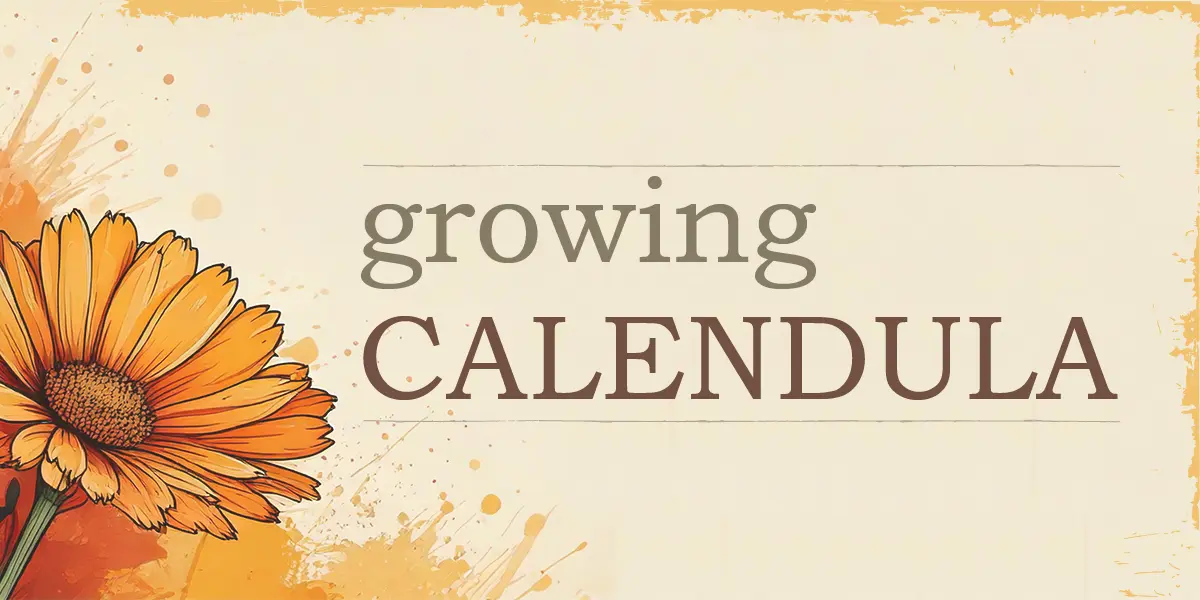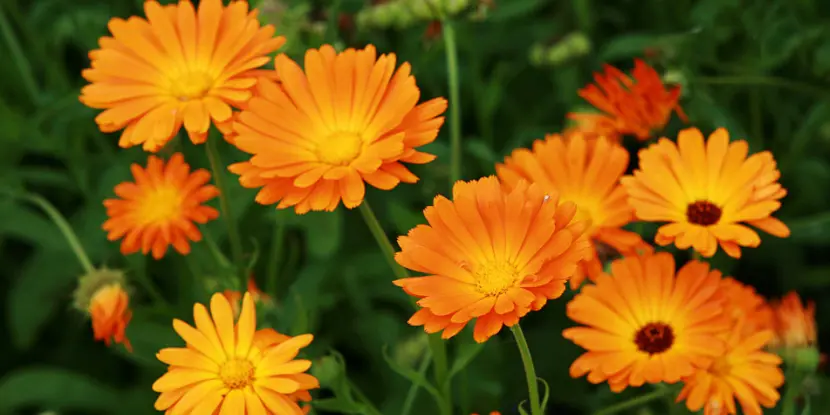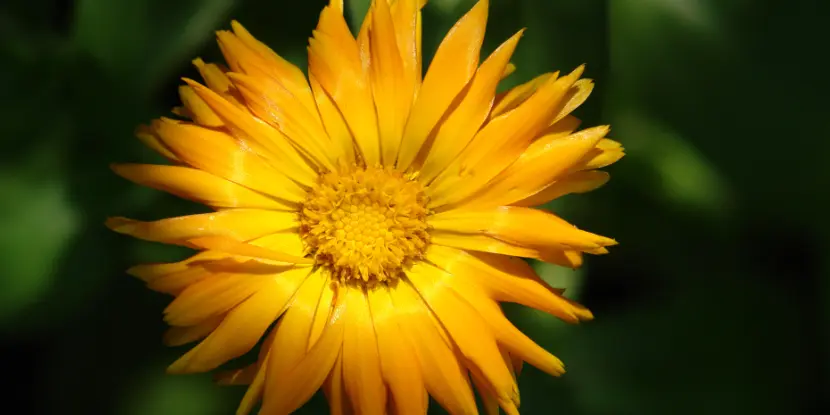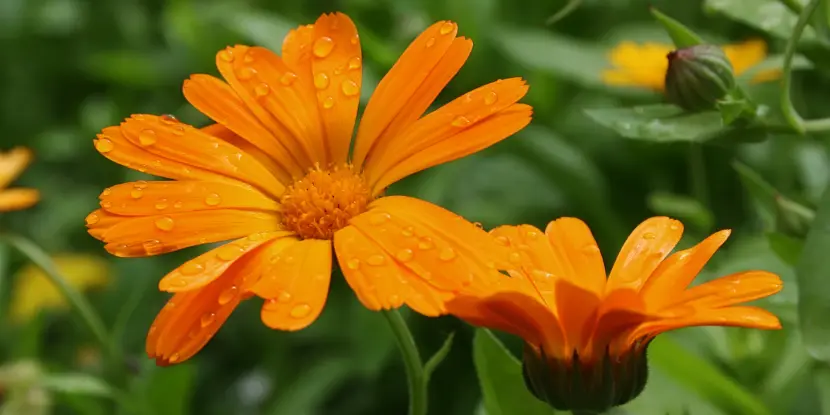Calendula is more than a pretty face — it’s a common ingredient in herbal teas, home remedies, and skincare products.
The sun-loving “pot marigold” is beautiful and edible, and its ability to attract pollinators makes it a beneficial garden plant, too.
- Calendula has anti-inflammatory, antifungal, and antibacterial characteristics.
- It’s a staple in creams to soothe dry or irritated skin.
- It can treat digestive issues and menstrual cramps.
- Its bright blossoms invite bees and butterflies to your garden.
- Calendula petals add color and flavor to salads, teas, and other dishes.
Calendula originates from the Mediterranean and parts of Europe, and is now grown worldwide.
5 Best Varieties for Southern California
- Pacific Beauty Mix: This vibrant orange and yellow variety thrives in Southern California’s sunny climate. It performs well in garden beds and containers.
- Resina Calendula: A top pick for medicinal use, Resina Calendula has a high resin content, making it ideal for skincare and home remedies. It bears flowers with golden-yellow petals.
- Alpha Calendula: Featuring large, bright orange flowers, Alpha Calendula is a robust variety that tolerates heat and adapts well to Southern California’s warm weather.
- Touch of Red Buff: This easy-to-grow variety offers intricate, soft apricot-colored blooms with red highlights at the tips.
- Radio Calendula: With its bold, spiky orange petals, Radio Calendula stands out in any garden. It’s exceptionally hardy and can endure the dry conditions of Southern California.
Optimal Growing Conditions
Light
- Calendula prefers full sun but can tolerate partial shade in hot climates.
- If grown in partial shade, it may produce fewer blooms.
Temperature
- It grows best in temperatures around 60–70°F (15–21°C).
- It’s frost-tolerant, but may struggle in extreme heat.
Soil
- Well-draining soil is crucial for calendula’s root health.
- Calendula can tolerate a wide range of soil pH levels, but neutral to slightly alkaline soils are best (pH 6.0–7.0).
Growing Calendula from Seed
1. Start Indoors or Outdoors
- Indoors: Begin 6–8 weeks before the last frost. Use seed trays filled with potting mix.
- Outdoors: Plant seeds directly in the garden after the last frost.
2. Plant the Seeds
- Sow seeds 1/4 inch (6 mm) deep and about 6–12 inches (15–30 cm) apart.
- Cover lightly with soil and water gently.
3. Germination
- Seeds typically germinate in 7–14 days.
- Keep the soil moist during this period.
4. Transplanting (if started indoors)
- Once seedlings have 2–3 sets of true leaves, harden them off and transplant them outdoors.
Calendula Care
Water
- Water regularly, but avoid overwatering.
- Soil should be slightly moist but not soggy.
Fertilizer
- Calendula doesn’t need heavy feeding.
- Use a balanced, all-purpose fertilizer once or twice during the growing season.
Pests & Diseases
- Watch for aphids and powdery mildew. Apply an organic insecticidal soap or neem oil to control pests.
- Prevent powdery mildew by providing adequate air circulation and avoiding overhead watering.
Pruning & Deadheading
- Deadhead spent flowers regularly to promote continuous blooming.
- Prune overgrown plants to maintain healthy growth.
Harvesting & Using Calendula
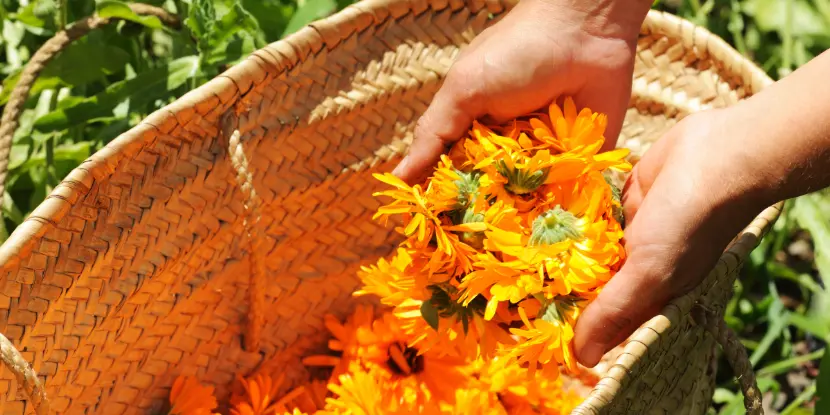
A healthy harvest of calendula blossoms.
Harvesting Flowers
- Harvest flowers when fully open, preferably in the morning after dew has dried.
- Remove the petals and discard the center portion of the flower.
Dry Flowers for Tea or Infusions
- Spread petals onto a baking sheet lined with parchment paper.
- Place in a well-ventilated area away from direct sunlight.
- Allow to dry for 1–2 weeks until crispy and brittle.
- Store in an airtight container until ready to use.
Fresh Flowers for Salads or Garnishes
- Rinse and dry the petals before adding them to salads, soups, or other dishes.
- Use as a colorful garnish on cakes and pastries.
Infused Oil
- Fill a jar with dried calendula petals.
- Cover with oil (such as olive or almond) and seal tightly.
- Place in a sunny spot for 4–6 weeks, shaking occasionally.
- Strain out petals and store infused oil in a dark glass bottle for up to 6 months.
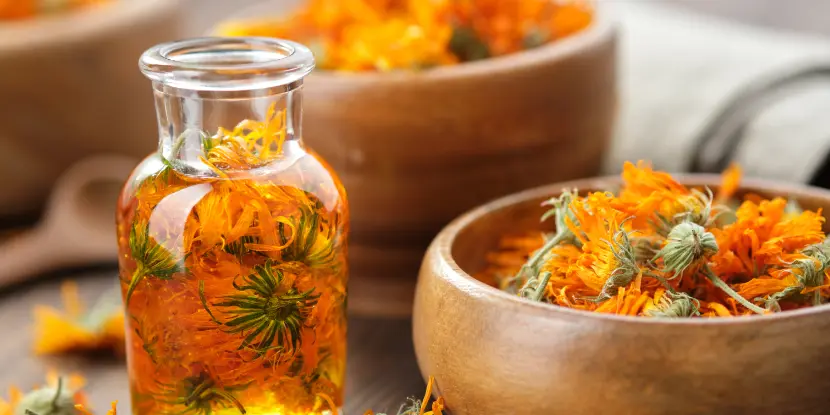
Calendula petals can be used in oil infusions, skin creams, and herbal remedies.
Calendula Cream
- Melt 1/2 cup of coconut oil and add 1/4 cup dried calendula petals.
- Let simmer on low heat for 3–4 hours.
- Strain out petals and let the oil cool.
- Whip with an electric mixer until creamy.
- Store in an airtight container in the fridge for up to 6 months.
FAQs: Growing Calendula
Q: Can I grow calendula indoors?
Yes, but place the pot near a sunny window and use well-draining soil.
Q: When is the best time to plant calendula seeds?
The best time is early spring after the last frost, but you can also sow seeds in fall for a late-season bloom in mild climates.
Q: How long does calendula bloom?
Calendula blooms continuously from spring to fall if you deadhead flowers regularly.
Q: Is calendula safe for pets?
Calendula is non-toxic to cats and dogs, but may cause digestive upset if ingested in large quantities.
Q: How much sunlight does calendula need?
Calendula can tolerate partial shade, especially in warmer climates. However, full sun will result in the most vibrant blooms.
Q: Can calendula survive frost?
Calendula can handle light frosts without issue. It performs well in cooler temperatures, but may struggle in extreme heat.
Q: How do I dry calendula flowers?
Harvest open blooms and spread them in a single layer on a drying rack or screen in a warm, well-ventilated area. Once petals feel dry and crisp, store them in an airtight container in a cool, dark place.
Q: Is calendula an annual or perennial?
Calendula is an annual, meaning it completes its life cycle in one growing season. However, some varieties may self-sow and return as volunteers.

